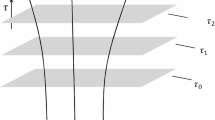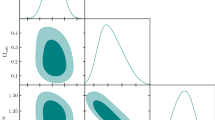Abstract
Is the Universe (a spatial section thereof) finite or infinite? Knowing the global geometry of a Friedmann-Lemaître (FL) universe requires knowing both its curvature and its topology. A flat or hyperbolic (‘open’) FL universe is not necessarily infinite in volume.
Multiply connected flat and hyperbolic models are, in general, as consistent with present observations on scales of 1–20 h−1 Gpc as are the corresponding simply connected flat and hyperbolic models. The methods of detecting multiply connected models (MCM’s) are presently in their pioneering phase of development and the optimal observationally realistic strategy is probably yet to be calculated. Constraints against MCM’s on ∼1–4 h−1 Gpc scales have been claimed, but relate more to inconsistent assumptions on perturbation statistics rather than just to topology. Candidate 3-manifolds based on hypothesised multiply imaged objects are being offered for observational refutation.
The theoretical and observational sides of this rapidly developing subject have yet to make any serious contact, but the prospects of a significant detection in the coming decade may well propel the two together.
Similar content being viewed by others
References
These parameters are defined as usual. The first two correspond to Ω m and ΩA in the popular Peebles [8] notation.
B F Roukema and V Blanloeil, Class Quant. Gravit. 15, 2645 (1998) (astro-ph/9802083)
J-P Luminet and B F Roukema, (1999) (astro-ph/9901364)
M Lachièze-Rey and J-P Luminet, Phys. Rep. 254, 136 (1995)
G D Starkman, Class Quant. Gravit. 15 2529 (1998) and the following articles in the same volume
V Blanloeil and B F Roukema (1999) http://www.iap.fr/users/roukema/CTP98/programme.html
J R Weeks, SnapPea, http://www.geom.umn.edu/
P J E Peebles, Principles of physical cosmology (Princeton Univ. Press, Princeton, USA, 1993)
‘Trivial topology’ refers here to the property of having a trivial π1 homotopy group
B F Roukema and A C Edge, Mon. Not. R. Astron. Soc. 292, 105 (1997)
B F Roukema and S Bajtlik, Mon. Not. R. Astron. Soc. (1999) accepted (astro-ph/9901299)
B F Roukema, 1999, submitted
S Perlmutter et al, (1999) (astro-ph/9812133)
Cosmic topology could provide high precision estimates of the curvature parameters. Detection of 5–10 multiple topological images of an object up to z ∼ 2–3 would be sufficient to estimate Ω0 and λ0 to better than 1% and 10% respectively [22].
R Lehoucq, J-P Luminet and M Lachièze-Rey, Astron. Astrophy. 313, 339 (1996)
R Lehoucq, J-P Luminet and J-Ph Uzan (1998) (astro-ph/9811107)
J-Ph Uzan, R Lehoucq and J-P Luminet (1999) submitted (astro-ph/9903155)
B F Roukema, Mon. Not. R. Astron. Soc. 283, 1147 (1996)
N J Cornish, D N Spergel and G D Starkman (1997) gr-qc/9602039
N J Cornish, D N Spergel and G D Starkman, Class. Quant. Gravit. 15, 2657 (1998b) (astroph/9801212)
J R Weeks, Class. Quant. Gravit. 15, 2599 (1998) (astro-ph/9802012)
B F Roukema and J P Luminet, Astron. Astrophys. submitted, 1999
Author information
Authors and Affiliations
Rights and permissions
About this article
Cite this article
Roukema, B.F. Topology of the Universe: Background and recent observational approaches. Pramana - J Phys 53, 945–949 (1999). https://doi.org/10.1007/s12043-999-0049-0
Issue Date:
DOI: https://doi.org/10.1007/s12043-999-0049-0




